Coalport porcelain
Coalport, Shropshire, England was a centre of porcelain and pottery production between about 1795 ("inaccurately" claimed as 1750 by the company)[1] and 1926, with the Coalport porcelain brand continuing to be used up to the present. The opening in 1792 of the Coalport Canal, which joins the River Severn at Coalport, had increased the attractiveness of the site, and from 1800 until a merger in 1814 there were two factories operating, one on each side of the canal, making rather similar wares which are now often difficult to tell apart.[2]
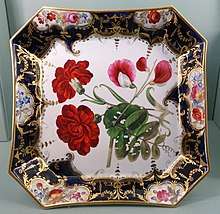
Both factories made mostly tablewares that had elaborate overglaze decoration, mostly with floral subjects. A further round of mergers in 1819 brought moulds and skilled staff from Nantgarw porcelain and Swansea porcelain to Coalbrook, which continued to thrive through the rest of the century. The Coalport factory was founded by John Rose in 1795; he continued to run it successfully until his death in 1841. The company often sold its wares as Coalbrookdale porcelain, especially the pieces with flowers modelled in three dimensions, and they may be called Coalport China.
Wares
.jpg)
Rose employed William Billingsley, formerly at Nantgarw, as chief painter, and Billingsley's chemist, Walker, who initiated at Coalport a maroon glaze and brought the Nantgarw technical recipes to Rose at Coalport.
Coalport and Coalbrookdale specialised in dinner services. The familiar "Indian tree" pattern, which is based in fact on Chinese rather than Indian prototypes, was originated at Coalport;[3] variants have been produced by virtually all the British manufacturers of table wares and continue to be available today. Models that originated at Meissen and Sèvres were copied at Coalbrookdale in the mid-19th century, sometimes with misleading marks,[4] "a practice which ought to have been avoided", William Chaffers observed.[5] Sprigged floral encrusted decoration was also typical of Coalport wares, such as vases, small boxes and table baskets.[6]
In 1820 Rose received the gold medal of the Society of Arts for his feldspar porcelain and an improved, lead-free glaze, with which the enamel colours fused in firing.[7] Favourite patterns were the "worm sprig" and the "Tournai sprig" introduced by Billingsley at Pinxton, the Dresden-inspired "Berlin china edge", and the blue transfer willow pattern and blue dragon pattern.[8]
During the 1830s the factory initiated the practice of applying a light transfer printed blue outline, to guide the painters. This preserved some of the freedom of hand-painted decoration, while it enabled Rose to keep up the pace of production.[9] The technique was widely adopted by other manufactories during the 19th century.
At The Great Exhibition (London 1851) an elaborate Coalport table service with deep borders of mazarin blue was shown; it had been commissioned by Queen Victoria as a gift to Tsar Nicholas I of Russia.[10]
In the second half of the 19th century the Coalport manufacturers added yet another specialisation to their repertoire of hand decorated porcelains. They developed the technique called “jewelling” whereby small beads of coloured enamel were applied most often to a gold ground. According to the auctioneers Skinner Inc, it is thought this was first developed and introduced by the Worcester porcelain factory in the mid 1860s. Turquoise seemed to be the prevalent colour, meticulously and uniformly decorating tea wares, useful wares and ornamental wares, often accompanied by a rich raised gold decoration. They were produced for sale in Britain and abroad. Two examples can be seen below.
Business history
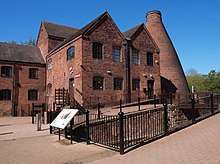
The Coalport porcelain manufactory, the first porcelain factory in the Ironbridge Gorge, England, was founded by the practical and enterprising John Rose in 1795. Financial support was provided by Edward Blakeway (1720-1811). John Rose had probably trained at the Caughley porcelain manufactory, less than a mile away on the other side of the Severn, and had been making pottery on his own account nearby at Jackfield, a mile upstream across the Severn from Coalbrookdale, since about 1793.[11] In 1799 Rose took over the Caughley factory, continuing production there, at least of the biscuit stage, moving the wares to be decorated at Coalport.[12]
From 1800-1814 Rose's brother Thomas operated a small works on the other side of the canal, initially with William Reynolds (d. 1803), an industrialist, and Robert Horton. After Reynolds' death his cousin Robert Anstice became a partner. They were taken over by J. Rose & Co. in 1814[13] The same year John Rose moved the Caughley production the short distance to the Coalport site.[14]
Rose's rapid success enabled him to buy the Nantgarw porcelain manufactory in 1819 and the Swansea porcelain manufactory, with their repertory of moulds.[15]
John Rose died in 1841; the enterprise was continued under the former name "John Rose & Co." by his nephew W.F. Rose and William Pugh. William Pugh continued the production as sole proprietor from 1862 until his death in 1875, after which the company was put in receivership by his heirs. It was purchased in 1880[16] by the East Anglian engineer Peter Bruff (d.1900), who reinstated it as the Coalport China Company. Under the management of his son Charles Bruff from 1889,[17] an extensive export trade to the United States and Canada was initiated in the 1890s, and the works were rebuilt on the original site in 1902.[18]
During the 1920s it fell again into financial difficulties and was eventually taken over by the Cauldon Potteries, Ltd., of Shelton, Staffordshire, in 1925.[19] In 1926 production moved to Staffordshire, the traditional centre of the ceramics industry in Britain, and, although the Coalport name was retained as a brand, in 1967[20] the company became part of the Wedgwood group.
Llewellynn Jewitt published a History of the Coalport Porcelain Works in 1862. The standard modern monographic history is Geoffrey A. Godden, Coalport and Coalbrookdale Porcelain (London 1970).
The original manufactory buildings now houses the Coalport China Museum, as well as a Youth Hostel, cafe, artists' studios and a handmade arts & crafts shop.[21]
 Early jug, c. 1796, with transfer-printed decoration. Soft-paste porcelain.
Early jug, c. 1796, with transfer-printed decoration. Soft-paste porcelain..jpg) Covered vase with scene of the factory and Coalbrookdale, c. 1810, 21 1/3 in. (54.19 cm) high
Covered vase with scene of the factory and Coalbrookdale, c. 1810, 21 1/3 in. (54.19 cm) high Plate, c. 1815
Plate, c. 1815- American scene "Hudson Highlands from Bull Hill", from a service, c. 1820-1830,
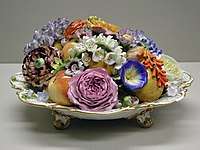 Floral centrepiece, c. 1840, bone china. This type of piece is often called Coalbrookdale porcelain
Floral centrepiece, c. 1840, bone china. This type of piece is often called Coalbrookdale porcelain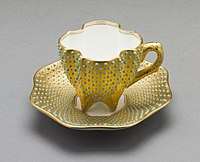 Jeweled demi-tasse cup and saucer "with sea-urchin foam", c. 1890
Jeweled demi-tasse cup and saucer "with sea-urchin foam", c. 1890 Jeweled bonbonnière, c. 1891-1919
Jeweled bonbonnière, c. 1891-1919_(cropped).jpg) Plate, before 1967 (1950s?)
Plate, before 1967 (1950s?)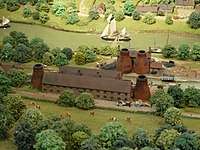 Diorama of the site, around 1820, in the Museum of the Gorge, Ironbridge
Diorama of the site, around 1820, in the Museum of the Gorge, Ironbridge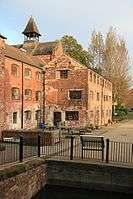 Earliest part of the original works at Coalport, now housing a café and hostel
Earliest part of the original works at Coalport, now housing a café and hostel
Notes
- Modern forms (since 1875) of the factory mark include this date, which evidently relates to the founding of Caughley, which Coalport later took over. But it is not correct for Caughley either; Battie, 179 ("inaccurately" quoted); the start at Caughley was "soon after 1750" according to Honey, 286.
- Honey, 324-325; Battie, 140
- Fleming and Honour
- Fleming and Honour
- Chaffers, 357; Dillon, notes in particular the rose Pompadour and turquoise grounds of "the pseudo-Sèvres porcelain that found its way to the London china-shops".
- Bushnell
- Chaffers 1866; Burton 1921:106; Edward Dillon, Porcelain.
- All noted by Chaffers.
- Fleming and Honour
- A sample plate is conserved in the Victoria & Albert Museum, London.
- Honey, 324
- Honey, 286
- Honey, 325; (Grove Encyclopedia of Decorative Arts, s.v. "Coalport Porcelain Factory"; for Rose's entrepreneurial spirit, see William Burton, A General History of Porcelain, 1921, vol. 2:102ff.
- Honey, 286
- A sketch of the factory's history, with marks including the Coalport monogram C (Coalport) and S (Salop) enclosing C, N and S for the three former factories, are in Chaffers 1866:356ff.
- Shropshire Archives, Ref. 1190/3/1133-1294, especially extension 1229, descriptive listings in The National Archives Catalogue.
- Burton 1921:105.
- J. Alfrey and C. Clark, The Landscape of Industry: Patterns of Change in the Ironbridge Gorge (Routledge 2005), p.99-100.
- M.F. Messenger, Coalport 1795-1926: An Introduction to the History and Porcelains of John Rose and Company (Antique Collectors' Club 1995), p. 406.
- The Potteries: Coalport Porcelain Works: sample of backstamps
- An illustrated history of the buildings is presented by R.S. Edmundson, "Coalport China Works, Shropshire: A Comparative Study of the Premises and the Background to their Development" Industrial Archaeology Review 3.2 (Spring 1979) 122-145.
References
| Wikimedia Commons has media related to Coalport Porcelain Factory. |
- Battie, David, ed., Sotheby's Concise Encyclopedia of Porcelain, 1990, Conran Octopus. ISBN 1850292515
- Burton, William (1921). A General History of Porcelain. 2. pp. 102ff.
- Bushnell, Gordon H. (2006), The Illustrated Guide to 19th Century Coalport Coalbrookdale Floral Encrusted Porcelain.
- Chaffers, William (1866), Marks and monograms on pottery and porcelain: with historical notices... (2nd ed.)
- Dillon, Edward (1904). "XXI - "English Porcelain - The Soft Paste of Derby, Worcester, Caughley, Coalport, Swansea, Nantgarw, Lowestoft, Liverpool, Pinxton, Rockingham, Church Gresley, Spode, and Belleek". Porcelain. London: Methuen.
- Fleming, John; Honour, Hugh (1977), "Coalport and Coalbrookdale porcelain factory", in Dictionary of the Decorative Arts
- Godden, Geoffrey A. (1970). Coalport and Coalbrookdale Porcelain. Barrie & Jenkins, London
- Honey, W.B., Old English Porcelain, 1977 (3rd edn.), Faber and Faber, ISBN 0571049028